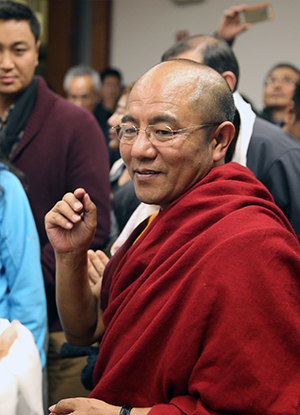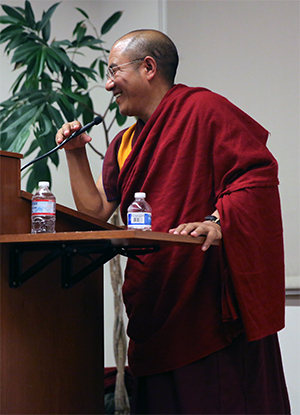The Popularity of Tibetan Buddhism in China
Listen to Khenpo Sodargye’s teaching in Stanford University to find out why Tibetan Buddhism is so popular in China. In these short videos, Khenpo candidly shares the reasons why Buddhism is more than just a faith and culture. It is actually about the listening, contemplating and practicing of Buddha’s teaching in order to achieve inner peace.
The Appeal of Tibetan Buddhism in China
Excerpt 1: What is Buddhadharma?
The essence of Buddhadharma is to abandon non-virtuous deeds, cultivate virtuous deeds and purify the mind. Always engage in virtuous deeds that benefit self and others and abandon non-virtuous deeds and thoughts that harm self and others including hateful and competitive feelings. Never be controlled by negative thoughts and maintain a calm and happy mind. This culture or education is Buddhadharma.
Excerpt 2: Studying the Buddhadharma
To study Buddhadharma, we need to first listen to teachings and contemplate them. Then we put the teachings into actual practice in order to increase our realization of the teachings. Vasubandhu said, “The wonderful Dharma can be classified into two types, the Dharma of transmission and the Dharma of realization. To practice the Dharma of transmission is to dispense Dharma teachings; to practice the Dharma of realization is to meditate on it”. Therefore, both teachers and scholars need to practice what they have learned in Buddhadharma. Otherwise they won’t be able to taste the ambrosia of the Dharma. It is also impossible for any Buddhists to be successful in their practice without hearing, contemplating and understanding the Dharma first. Hence, it is very important to combine theory with practice.
Excerpt 3: Benefits of Studying Buddhism
To study Buddhism, one should have faith and an interest in the teachings. Meanwhile, keep an unbiased attitude and apply wisdom in the study of the teachings, which will increase our understanding over time, and eventually lead to the uncovering of the nature of mind akin to the dispelling the clouds and seeing the sun. From thereon, there will be no impediments for you to give Dharma teachings, practice, and debate with others on truths and you will be qualified to accept disciples.
However, nowadays there are few who have realized the nature of mind, like what’s described in a Tibetan saying, “It is easy to get lost in the dense fog; it is easy to break legs on the frozen ground”. Without any religious beliefs, they are bewildered and are lost.
In general, Buddhism will bring about world peace and social harmony. From a micro perspective, it benefits the family, human relations and environment.
Excerpt 4: Physical and Mental Wellbeing
There are many methods in Buddhism that are helpful to our physical and mental well-being. For example, the practices of meditation, altruistic bodhicitta and emptiness can solve many problems that we face in our daily lives.
Excerpt 5: The Appeal of Tibetan Buddhism in China
The growing appeal of Tibetan Buddhism in China is not without reasons. Firstly, Tibetan Buddhism offers a systematic approach to studying Buddhadharma. The tradition is strong in Tibetan monasteries as the education is availed continuously like in a university. Secondly, Tibetan Buddhism is a source of special blessing or power as it is complete with teachings of both Sutrayana and Tantrayana. Through the practice of these teachings, one’s mind can be changed and tamed. Thirdly, the spiritual teachers from Tibetan regions have the altruistic mind to benefit sentient beings through various means such as teaching the Dharma or chanting the mantra, etc. Although there are a few fake Tibetan gurus in the Han region, they are just problems of these individuals, not Buddhism. Lastly, Tibetan Buddhism offers the complete exoteric and esoteric teachings of all traditions, from the teachings in Theravada, Han and Japanese Buddhism to tantric teachings of Mahayoga, Anuyoga and Atiyoga.

What is Buddhadharma?
The essence of Buddhadharma is to abandon non-virtuous deeds, cultivate virtuous deeds and purify the mind. Always engage in virtuous deeds that benefit self and others and abandon non-virtuous deeds and thoughts that harm self and others including hateful and competitive feelings. Never be controlled by negative thoughts and maintain a calm and happy mind. This culture or education is Buddhadharma.

Studying the Buddhadharma
To study Buddhadharma, we need to first listen to teachings and contemplate them. Then we put the teachings into actual practice in order to increase our realization of the teachings. Therefore, both teachers and scholars need to practice what they have learned in Buddhadharma. Otherwise they won’t be able to taste the ambrosia of the Dharma.
“Tibetan Buddhism is flourishing in China as many young people and intellectuals are attracted to it. Compared with people in the past, they not only believe in Buddhism but also actually engage in the study, contemplation and practice of the Buddhadharma. As a result, there is an increase in the number of Buddhists, as well as an improvement in their understanding of the Buddhadharma.”
















